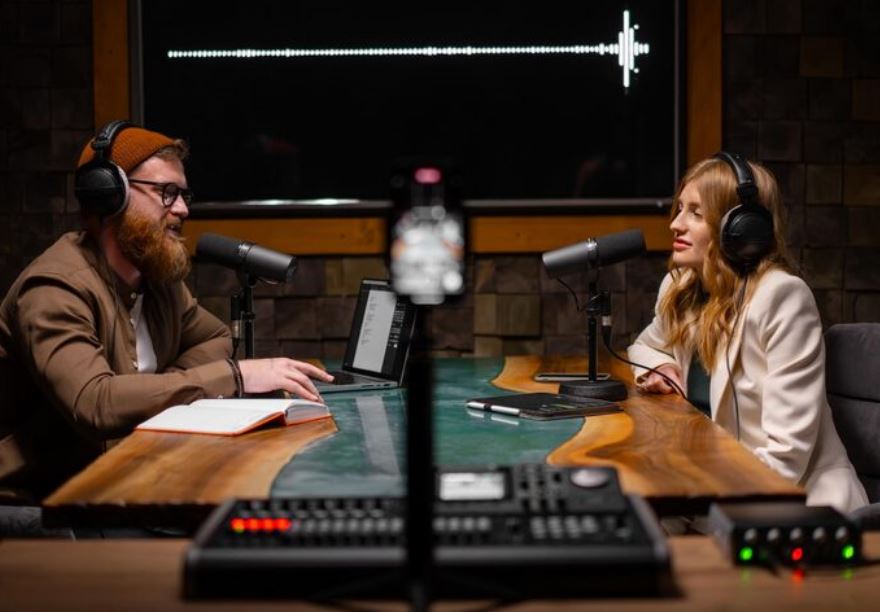
Podcasting has transformed from a specialized creative outlet to a highly significant media battlefield in recent years. The way people consume news, entertainment, and stories has been drastically changed by the so-called Podcast Wars, a broad competition between media companies, tech platforms, and celebrities. Although the saga is quieter, more intimate, and more personal, it feels remarkably similar to the streaming wars.
Particularly creative was Spotify’s transition from a straightforward music app to a storytelling powerhouse through its foray into podcasting. Spotify made it clear it wasn’t content to settle for second place by purchasing Gimlet Media and The Ringer, and then landing exclusives like The Joe Rogan Experience. The company’s strategy was incredibly successful; rather than merely disseminating content, it created an ecosystem that combined culture and technology. Spotify developed a listening experience that felt personalized, poignant, and incredibly human through data analytics and strategic alliances.
| Category | Details |
|---|---|
| Major Platforms | Spotify, Apple Podcasts, YouTube, Amazon Music, Wondery |
| Key Creators | David Brown, Dan Rubenstein, Dax Shepard, Alex Cooper, Joe Rogan |
| Landmark Series | Business Wars, Sports Wars, Armchair Expert, Call Her Daddy |
| Production Leaders | Wondery, Gimlet Media, Spotify Studios, NPR, Barstool Sports |
| Defining Rivalries | Spotify vs Apple Podcasts, YouTube vs Spotify, Wondery vs NPR |
| Innovation Highlights | Subscription models, video podcasting, data-driven discovery |
| Key Period | 2018–2025: Explosive competition and innovation phase |
| Cultural Impact | Rise of conversational media, celebrity migration to podcasts |
| Audience Reach | Over 450 million monthly listeners globally |
Conversely, Apple saw its long-standing supremacy wane as rivals surpassed its once effortless command of the audio market. For many years, Apple Podcasts served as a silent repository for the top voices on the internet. However, its share had drastically decreased by 2020. Apple changed its strategy from competing on volume to curation, prioritizing quality over quantity. Its emphasis on premium subscriptions, editorial storytelling, and exclusive shows proved especially advantageous for viewers who preferred sophistication to noise.
YouTube, meanwhile, joined the battle with remarkable strategic clarity. It produced a new hybrid medium by seamlessly fusing audio and video, making it difficult to distinguish between viewing and listening. The video podcast trend was very flexible; audiences could choose how to interact with the content, and creators could convey personality, body language, and emotion. The popularity of YouTube podcasts significantly increased accessibility, allowing audiences around the world to visually engage with even the most complex discussions.
In this changing environment, Wondery, the audio studio behind Business Wars and Sports Wars, emerged as a silent but potent disruptor. Wondery transformed business rivalries into engrossing dramas, founded on the idea that competition creates great stories. The way business storytelling could sound was redefined by David Brown’s narration in Business Wars, which followed rivalries like Netflix vs. Blockbuster or Nike vs. Adidas. In addition to being captivating, it was remarkably resilient in terms of cultural memory. Every episode was intellectually stimulating, emotionally complex, and cinematic.
Dan Rubenstein’s Sports Wars, which turned athletic rivalries into human dramas, reflected this success. From McGregor vs. Khabib to Federer vs. Nadal, these matches encapsulated both rivalry and personality. By focusing on psychology, pride, and tenacity, the series turned into a reflection on ambition in general. It demonstrated how audio storytelling could be just as intense as live sports, and the format was very effective at keeping listeners interested.
Wondery’s productions accomplished something extremely uncommon by utilizing cliffhanger pacing, music scoring, and storytelling to transform passive listening into active immersion. Since then, major networks like NPR, iHeart, and The New York Times have adopted serialized structures and cinematic sound design as a result of their model. By connecting journalism, entertainment, and documentary, this development in podcasting has significantly raised the artistic legitimacy of audio media.
Additionally, the Podcast Wars have sparked a celebrity migration that has reshaped the definition of fame in the digital era. People like Alex Cooper (Call Her Daddy) and Dax Shepard (Armchair Expert) transformed conversation into business. They provided unvarnished looks into contemporary life by establishing areas of humor and vulnerability. Their success showed how relatability itself could become a brand and how personality could compete with production value. Cooper’s $60 million transfer from Barstool Sports to Spotify was a particularly notable example of how the industry was changing.
Podcasts served as emotional lifelines during the pandemic, when isolation stifled many human connections. Hearing someone else’s voice up close, uncensored, conversational, and incredibly genuine, was incredibly reassuring. This change greatly broadened the emotional scope of podcasting, transforming it into a cultural mirror reflecting commonplace challenges and goals. For an audience that prioritized authenticity over spectacle, the medium essentially turned into a digital confessional.
The independent creators subtly maintained the ecosystem’s authenticity behind the glitz of major deals. Podcasters were able to keep their artistic freedom and receive direct audience support through Patreon and Substack. This grassroots approach was especially novel since it gave voice to marginalized groups and subjects that were frequently ignored by the media. It demonstrated that sincerity and nuance could still prevail over marketing budgets and algorithms.
But the competition is still getting fiercer. The addition of podcast tabs to YouTube in recent months has put it squarely in competition with Spotify’s curated feeds. Apple’s focus on editorial storytelling has drawn well-known collaborations, but Amazon’s strategy of combining Wondery+ with Prime has been surprisingly successful in drawing in casual listeners. It feels like a chess piece moving forward with each move, leading to an exciting but uncertain future.
The advantages for listeners have been enormous. Creators now have more freedom than ever before, diversity of voices has flourished, and content quality has significantly improved. However, the saturation has also prompted concerns about attention span, authenticity, and discovery. Because there are so many options, the true struggle is for trust rather than dominance. Voices that feel deeply human are the ones that reverberate the most in a noisy environment.
These podcast wars have changed cultural norms and redefined media over the last ten years. Audio has evolved into a place for introspection, education, and friendship. Listeners are now active participants in cross-generational and cross-continental dialogues rather than passive consumers. Every rivalry, from Wondery’s storytelling to Spotify’s strategy, has pushed the industry into a new era where innovation seems limitless.
